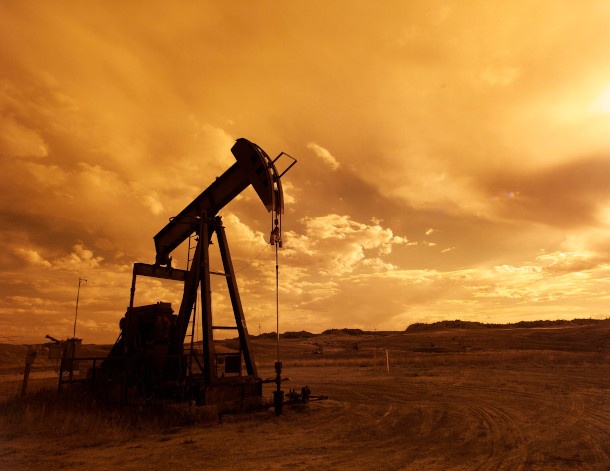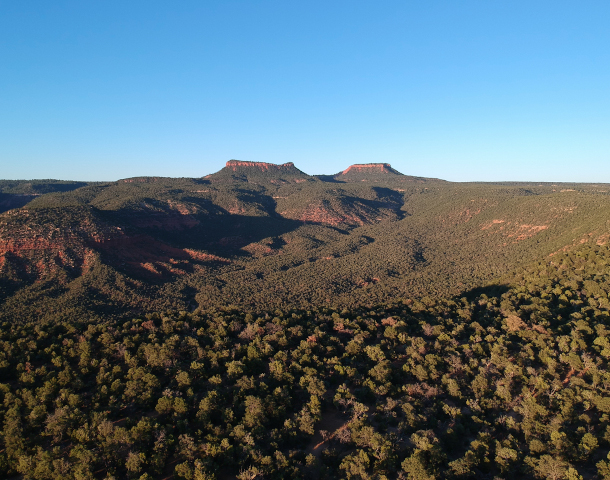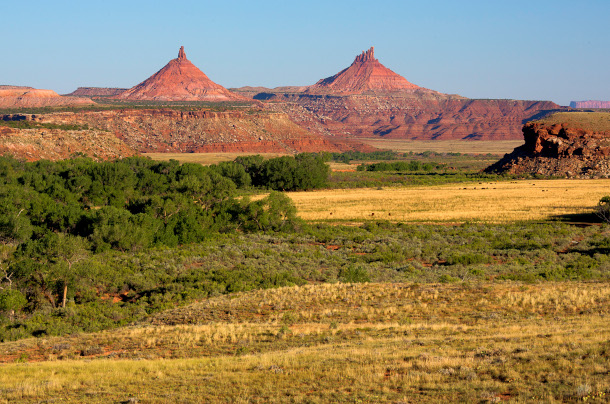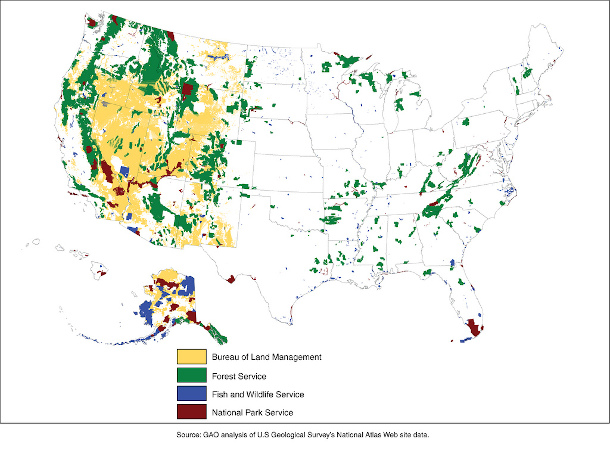Interior’s Next Frontiers
Air Date: Week of January 15, 2021

An oil pumpjack stands near Casper, Wyoming. President-elect Biden has pledged to stop issuing new leases for oil and gas drilling on public lands during his time in office. (Photo: US Department of Energy, Flickr, Public Domain)
After four years in pursuit of extraction at the expense of conservation, the Department of the Interior is about to undergo a major change in how it manages federal public lands and relates to Native Americans. Sally Jewell, former U.S. Secretary of the Interior under President Obama, joins Host Bobby Bascomb to discuss how the Biden administration can halt the advance of oil and gas extraction on public lands, attract more renewable energy and restore the sacred Bears Ears National Monument.
Transcript
BASCOMB: Assuming she is confirmed, Deb Haaland has her work cut out for her. She’ll be the top boss for more than 400 sites and 85 million acres in the National Park system. She’ll also be in charge of the Fish and Wildlife Service, which oversees endangered species protections and manages roughly 150 million acres in the National Wildlife refuge system. And she’ll have final say at the Interior Department about the quarter of a billion acres of other public lands handled by the Bureau of Land Management, and whether or not those lands, along with offshore areas, be mined for coal, gas, and oil. Deb Haaland also would be the first Native American to direct Interior which manages federal relations with more than 570 Native American tribes. And following the lead of President-Elect Biden, she’s expected to move to reverse President Trump’s extraction-friendly and climate-oblivious agenda. Sally Jewell served as Secretary of the Department of Interior under President Obama, and joins us now with some insights into what her old job could be like for Deb Haaland. Welcome back to Living on Earth, Secretary Jewell!
JEWELL: Thank you. It's great to be here, Bobby.
BASCOMB: President-elect Biden has pledged to grant no new oil and gas leases on federal lands and waters. How realistic is it to expect that the Department of Interior, would it be able to follow through on that pledge?
JEWELL: Well, the reality is that the program for oil and gas leasing, just as it was for coal leasing, has not been reviewed in many decades. And it is important that it be reviewed, and I would absolutely launch what's called a programmatic environmental impact statement on the federal leasing of lands and waters for oil, gas and mineral extraction. You know, would that undermine, you'd immediately have a human cry saying, "Well, wait a minute, you know, there's a lot of jobs at stake," and so on. There are many jobs, certainly, in the oil and gas sector. But there's also over 10,000 permits to drill that are issued already that haven't been drilled. There is a pent-up supply of existing leases that can be developed, as long as, you know, they make sense to develop and they, they follow regulatory guidelines. So it makes all the sense in the world to say, let's put a pause on it. You got plenty in your pipeline already, pardon the pun. We have to do things as a public servant that are in the public's interests, not in supporting special interests. And that's what needs to happen. And I think it should happen relatively quickly.

Bears Ears is an area in southeastern Utah, sacred to many Native American tribes. The Bears Ears National Monument was created by President Obama and extensively reduced in size by President Trump (Photo: Bruce Rinehart, Wikimedia Commons, CC BY-SA 4.0)
BASCOMB: What are some of the other ways that the Department of Interior might be able to curb greenhouse gas emissions and even help us transition to more renewable energy?
JEWELL: Well, the Department of the Interior has a major role. And one of the things that I noted early on in my time as Secretary of the Interior was that in my first six weeks on the job traveling around the lands and waters that were under the jurisdiction of the Department of the Interior, that climate change was everywhere I looked. On the landscapes and in the waters, you could not deny that it was going on, it's very obvious. The Department of the Interior and the 20% of U.S. lands that are under its jurisdiction, in addition to the additional 10% that is under USDA and the Forest Service, are massive forests and reservoirs for carbon sequestration. They are wetlands and dunes and mangroves and wildlife refuges that protect inland communities from coastal flooding, and sea level rise. They are national parks and protected lands and wildlife corridors that are absolutely critical to biodiversity, especially at this time of climate change. So Interior's role is multifaceted. But the Department of Interior also plays a major role in mitigating climate change by finding alternative sources of energy to fossil fuels, and reducing the consumption of fossil fuels in our country. So, great example, during the time that the Obama administration was in charge, we had a massive effort in the whole Mojave Desert and Sonoran Desert in California around land use planning to drive renewable energy in the right ways and in the right places. So we did all the scientific research around endangered species like the desert tortoise, around the bird migration corridors and wind energy, around the prospective migration corridors for bighorn sheep, which were endemic to that area, around areas that needed to be protected as Joshua trees, for example, move upslope. And we said to industry, if you develop in these areas that have been set aside for utility-scale, renewable energy, we will expedite your permitting. That's thoughtful regulation that drives renewable energy development to the right places, that are close to transmission, already in disturbed areas, have been pre-cleared with the environmental impact statements already done, so that they can get that solar farm or wind farm up and operational much quicker and a much lower cost. So those are some of the things that interior can and is doing that are really, really important in addressing climate change, and looking to shift from our dependence on fossil fuels to non-carbon emitting sources of energy that are really critical for our economy.

Two sandstone summits, called the Sixshooter Peaks, rise above the horizon of the Bears Ears National Monument. (Photo: Bureau of Land Management, Wikimedia Commons, Public Domain)
BASCOMB: Now, if Deb Haaland is confirmed, she will be the first Native American in charge of the Department of Interior, which of course oversees the Bureau of Indian Affairs. What do you see as the challenges and opportunities for the Department of Interior when it comes to working with native peoples?
JEWELL: During my time as Secretary of the Interior, one of the most rewarding parts of the job was getting to know the indigenous communities within the United States. I came to deeply respect and appreciate the relationship of these indigenous peoples to the land, and their deep understanding of a landscape in balance. You know, there's a concept of wilderness being "untrammeled by man," which is mythology. It has been trammeled by man, and lived in harmony by man, since time immemorial, including in, in the United States, at least for parts of the country since the Ice Age, you know, tens of thousands of years ago. So I hope that the Department of the Interior rebuilds that respectful relationship. And if Congresswoman Haaland is confirmed as Secretary, I know that will be a priority of hers. Bring back the Tribal Nations Conference and invite tribal leaders back to Washington D.C. Reinstate the White House Council on Native American Affairs and bring all of those agencies together, because yes, Interior is involved and is viewed as an advocate. But every single agency of the federal government must do its part to uphold trust and treaty obligations to our nation's first people. And we have not done a good job.
BASCOMB: Now, Secretary Jewell, you were closely involved in working with tribes and other stakeholders to get the Utah Bears Ears National Monument designation across the finish line during the Obama administration. Then the Trump administration came along and cut the size of that monument by roughly 85%, basically to allow for fossil fuel extraction. What can a Biden Interior Department do to try to restore that?

A map of all federally owned lands in the United States. (Photo: U.S. Government Accountability Office, Flickr, Public Domain)
JEWELL: Well, first, the rescinding or shrinking of Bears Ears National Monument has been challenged in the courts, and has been making good progress. I hope and expect that the Biden administration will reinstate Bears Ears National Monument, and Grand Staircase-Escalante National Monument. The one thing that is unique about Bears Ears, and there couldn't have been a place that's more tailor-made for the Antiquities Act, than Bears Ears, is that it is sacred to five different tribes that advocated for it. There are over 100,000 cultural sites, and I've been to many of them. They teach us stories about these people and how they lived. As I went deep into the monument after leaving Interior with a guide, I saw a sandal made 1200 years ago, that was tightly woven, intricately woven. And I saw another sandal that was 400 years newer, that was a coarser weave. And what do we learn from that? The Basketmaker period, to the period of pottery. Those early baskets needed to carry water. The later weaving was to protect the bottom of your foot, but it didn't need to carry water, right? So they had lost that technique in that intervening years, even though that coarsely woven sandal was newer. These are lessons you learn from a place like Bears Ears, and of course, why are the sandals there? Most likely erosion around burial sites. There are cliff dwellings all over the place. And they were being looted. And many of those artifacts, like the sandals that I described, will not be there. Because people will go up and take a picture with their iPhone, and they'll post it on their Instagram. And they'll think, gosh, isn't this cool? And somebody else will see exactly where that is. They've just given them instructions with the geo tagging. So the threat was there. The Trump administration undermined it for no good reason, it absolutely needs to be reinstated. But I also think the Antiquities Act could be clarified so this never happens again.
BASCOMB: The events of January 6, have made it very clear just how very divided we are as a country right now, I think a lot of us were shocked to see those images. But one of our greatest treasures, I think, are the public lands that we've been talking about here, that belong to all of us. To what extent do you see places like that, our national parks and monuments, as spaces, you know, that can ideally bring Americans together in some way?

Sally Jewell, former US Secretary of the Interior under President Obama. (Photo: Wikimedia Commons, Public Domain)
JEWELL: Our public lands have become more obviously important to more people during this global pandemic of Covid-19 than they were before. They have always been America's public lands, not Republican national parks and public lands, or Democratic, but America's public lands. And I think that's really important. I will say that, how we use our public lands and who owns them and what that means is not universally understood in the same way across the country. Some of the people who are now being charged with the riots and the insurrection on Capitol Hill on January 6, are some of the same groups that we dealt with in trying to uphold the laws, for example, in Bunkerville, Nevada, with the Bundy family, who had not paid grazing fees for over 20 years and was in arrears to the federal government. There was a Sagebrush Rebellion some years back; I had to deal with the occupation of the Malheur National Wildlife Refuge by members of the Bundy family, but a number of the people associated with some of the groups that have been named in the recent attacks on the Capitol. Some people view it as their birthright to use public lands for their own private purposes. And one of the great blessings that we have as Americans is that the best places around our country were not set aside for kings and queens and nobility, as they are in so many other parts of the world. The best places were set aside for all of us, through our public lands, and, of course, the crown jewel of those being our national parks. And I hope that as we look to the future, we recognize that value and we care for these places. And in making difficult decisions, as Secretary of the Interior, there is a proverb that I have always used to think about the decisions that I had to make, and that is that we don't inherit the earth from our ancestors, we borrow it from our children. And when you think about that, and you think about the difficult decisions that you have to make, it gives you a different lens that says, this is not just for today, these decisions are going to impact generations yet to be born. And am I thinking about that, in all of the work that I do every single day in stewarding these resources forever.
BASCOMB: Sally Jewell served as Secretary of the Interior under President Obama. Secretary Jewell, thank you so much for taking this time with me today.
JEWELL: Thank you for having me, Bobby, and I appreciate the great work of Living on Earth.
Links
The Nature Conservancy | “About Sally Jewell”
Washington Post | “Biden Vowed To Ban New Drilling on Public Lands. It Won’t Be Easy.”
Bears Ears Inter-Tribal Coalition | “Bears Ears National Monument: Native American Connections”
Living on Earth wants to hear from you!
Living on Earth
62 Calef Highway, Suite 212
Lee, NH 03861
Telephone: 617-287-4121
E-mail: comments@loe.org
Newsletter [Click here]
Donate to Living on Earth!
Living on Earth is an independent media program and relies entirely on contributions from listeners and institutions supporting public service. Please donate now to preserve an independent environmental voice.
NewsletterLiving on Earth offers a weekly delivery of the show's rundown to your mailbox. Sign up for our newsletter today!
 Sailors For The Sea: Be the change you want to sea.
Sailors For The Sea: Be the change you want to sea.
 The Grantham Foundation for the Protection of the Environment: Committed to protecting and improving the health of the global environment.
The Grantham Foundation for the Protection of the Environment: Committed to protecting and improving the health of the global environment.
 Contribute to Living on Earth and receive, as our gift to you, an archival print of one of Mark Seth Lender's extraordinary wildlife photographs. Follow the link to see Mark's current collection of photographs.
Contribute to Living on Earth and receive, as our gift to you, an archival print of one of Mark Seth Lender's extraordinary wildlife photographs. Follow the link to see Mark's current collection of photographs.
 Buy a signed copy of Mark Seth Lender's book Smeagull the Seagull & support Living on Earth
Buy a signed copy of Mark Seth Lender's book Smeagull the Seagull & support Living on Earth

